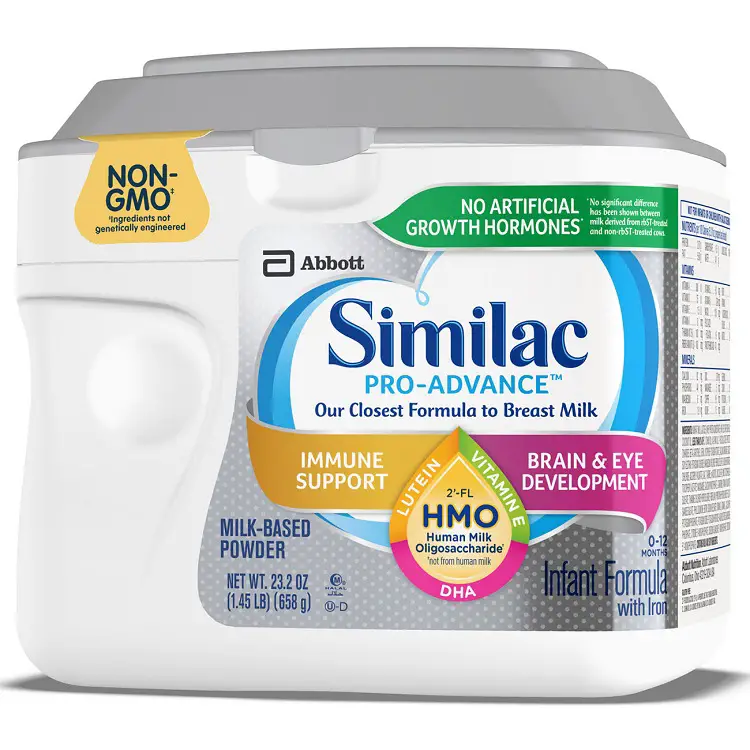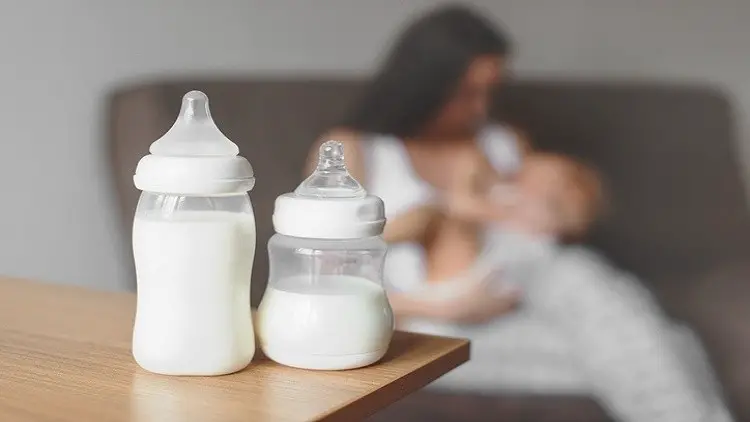Are you wondering how to transition from breast milk to formula with your baby? Don’t worry you’re not alone. Every breastfed baby will react and adapt differently when it comes to weaning from breastfeeding and transitioning to a bottle or cup.
If you decide to breastfeed, hopefully, it was an amazing bonding experience for you and your baby. But like all milestones, all good things must come to an end.
You should be glad to have made it this far! If you still find breastfeeding satisfying and fun and dread giving it up, you have no reason to stop breastfeeding your baby altogether.
The AAP (American Academy of Pediatrics) recommends breastfeeding the baby exclusively for about 6 months, and longer if both mother and child are comfortable.
What if you’re not interested? If your breast milk supply is waning (maybe your baby seems fussy and still hungry after feeding or isn’t gaining enough weight), or if pumping at work is uncomfortable, it might be time you begin transition gradually her over to formula or if you decide to wait till she clocks 1, you can wean her straight to whole cow’s milk from a cup.
When To Wean Baby From Breastfeeding?
Deciding when it’s time to wean off breast milk is different for all babies. Some babies keep their attachment to nursing well into toddlerhood while others show may seem less interested and start to self-wean before their first birthday; this is usually common between 9 and 12 months.
The AAP (American Academy of Pediatrics) recommends exclusive breastfeeding for about the first 6 months of the baby’s life and continues offering a blend of breast milk and solid food until his first birthday.
And if the new feeding arrangement is working for both you and the baby, it’s perfectly ok to continue. If you decide to wean sooner, that’s ok.
The decision of when to stop breastfeeding a baby is a personal decision, and every mother should do what they feel is best for her and the baby.
However, weaning usually seems to be easier when you follow your baby’s cues and let her lead the way. While mother-initiated weaning is completely achievable, going against your child’s preferences can make the process a little bit difficult.
Usually, there are some situations when you should try to avoid weaning if possible. You might decide to hold off if:
- Your Baby Is Sick Or Teething: Your baby will have an easier time with the change when she’s at her best.
- Your Family Is Going Through A Transitional Period: Resuming work, starting with a new caregiver, or relocating with your family can be stressful. Hold on until things have settled before adding another big change.
- Your Family Has A History Of Food Allergies: If you or your partner has food allergies, breastfeeding may decrease your baby’s chances of becoming sensitized to some particular allergens.
- You’ve Had An Off Day Of Breastfeeding: Some days are just not smooth. It’s perfectly ok to stop if nursing continues to be challenging or less fun. But, remember to give yourself some time (A few weeks) before making a final decision.
Read Also: How To Make Formula Taste Like Breast Milk
Why Most Mothers May Want To Switch From Breast Milk To Formula
All babies are different. Normally, every breastfed baby will react and adapt differently when it comes to transitioning from breast milk to formula. One important thing to look out for is how your baby reacts to the changes.
Whether you are just supplementing your breast milk or you’ve completely decided to switch from breast milk to formula, it should be done properly to make the transition a stress-free one. There are many reasons why a mother may decide to introduce bottle-feeding or switch from breast milk to formula.
The reasons could be health-related or for convenience. Many mothers may switch to formula for some reasons:
- They don’t produce enough breast milk.
- They resume work and it is too stressful or too demanding to pump at work.
- They decide on a cut-off point (like in 6 months, 9 months, a year, etc.) and just stop.
- They need to take on certain drugs that are not safe for breastfeeding babies.
- They are just tired of pumping and nursing.
- Baby’s inability to feed efficiently.
When the baby’s teeth develop, some nursing mothers experience a lot of nipple biting which is another common reason to switch from breastfeeding to formula. Whatever the reason for the switch from breast milk to a formula is, replacing breast milk suddenly with formula may not be that easy for you or your baby.
Read Also: 13 Best Formulas That Taste Closest To Breast Milk
How To Transition From Breast Milk To Formula Easily

All the information and advice out there says to start slow. That is to mix formula and breast milk in a 1:1 ratio and sees if your baby likes it. If she does not, mix a 1:4 formula: breast milk ratio and then increase to 1:1 after a few feeding sessions, then to 4:1 formula: breast milk, then 100% formula.
Sadly, our daughter’s food pickiness made it much more difficult. Trying to switch her from breast milk to formula was a tough task. She refused to drink breast milk with ANY formula in it, even when it’s a 1:12 mixture.
She gagged and vomited from just the smell and flavor of formula. Well, that stuff tastes GROSS I don’t blame her. What we did was, we started slow. We combined 1/2 teaspoon of soy formula into a 6 oz. bottle of breast milk.
She drank it without any fuss. We were SUPER EXCITED! We maintained this combination for 3 full days (3 bottles a day) before we increased it to a whole teaspoon. We wanted her to get used to the taste before we add more formula.
So, every 3 days, we increased the quantity of formula by 1/2 a teaspoon. Nothing more, we didn’t want to risk our daughter suddenly tasting the formula and hating it, then all our efforts would have been useless.
If we ever gave her a smaller or larger amount of milk, we did some crazy ratio analyses to get exactly the right quantity of formula into the bottle so the ratio would stay the same.
I had a little cheat sheet going at some point to prevent me from calculating each day. We checked how many teaspoons of formula were in a scoop (3 teaspoons for most brands!), and ultimately we were up to 1 whole scoop of formula in a 6 oz. bottle.
By then, we were able to switch 1 ounce of breast milk for 1 ounce of water (because our formula instructions called for 1 scoop of a formula for 1 ounce of water).
And we continued doing it like this for over a month to fully make the transition. Fortunately, I had plenty of frozen breast milk so I had enough time to do this transition slowly.
If you’re in a rush to make this transition because you’re low on supply, resuming work, or you need to begin a medication soon, then maybe you can try going twice as fast.
However, if your baby is super picky who dislikes formula as our daughter at first, then I wouldn’t recommend going any faster. Eventually, we switched from breast milk to formula to a mix of soy milk + a little formula, a mix we are happy with.
Why we choose this mix (soy milk + formula) is that soy milk doesn’t have as many calories as cow’s milk, and our baby is pretty underweight. Also, the formula is not that cheap! At 2 years and 6 months old we still supplement some calories into the soy milk by adding a little soy formula.
Our daughter still LOVES his milk and drinks at least two 6-oz bottles per day. Once she starts eating better (thanks to feeding therapy!) we will eventually transition OFF the formula to just soy milk by following similar gradual steps I describe above.
Read Also: Is It Ok To Mix Breast Milk With Formula?
Tips For A Smooth Transition
1. Talk To A Pediatrician
Before making any switch to your baby’s food selection, get expert advice from your baby’s pediatrician first. It’s consoling, especially for first-time moms, to have an expert backup when making new decisions that involve their baby.
Your child’s health care provider can provide helpful tips to help you introduce the formula and may recommend particular formulas to you. If there are further concerns, particularly about the formula they recommended, you can always reach out to them to get all your answers.
2. Make A Gradual Introduction
Be patient when introducing formula at first. It’s vital to test the field first and see how your baby responds and adapts. You can then switch fully if there’s no response, or your baby doesn’t seem to care much about what you are feeding her.
3. Offer Expressed Breast Milk In A Bottle
Getting breastfed babies to feed on a bottle that isn’t attached to their moms is one difficult part of transitioning. However, it is not impossible. After all, practice makes perfect. To get your baby to easily feed on a bottle, begin by filling the bottle with breast milk.
Once your baby gets comfortable with feeding from a bottle, switching to the formula will be a lot easier. Also, remember to choose the right bottle for your baby. I suggest you use baby bottles made out of exceptional tempered glass because they’re durable, non-toxic, and safe for the environment.
4. Channel Baby’s Attention To The Bottle
This might appear tricky to get babies that have been breastfed to want milk that is not from their mother, particularly because babies can sense the breast milk from their moms.
To get such babies to bottle-feed; you should try to get their minds off you in the most ideal way. You can try telling a story, singing a song she loves, making a playful face, or anything else you can do to distract her, and then channel her attention to the bottle.
5. Drop Feeding Sessions Gradually
Making a stress-free switch from breast milk to formula requires patience. Gradually, drop one breastfeeding session and use formula instead.
For example, if you breastfeed your baby 8 times in 24 hours, try going 7 times on the breast and offer a bottle for the eighth feeding session or you can use the method we applied with our daughter above. Remember, you should keep dropping breastfeeding sessions until your baby is weaned off breast milk.
Read Also: How Many Nursing Pads Do I Need?
6. Formula In The Day
Babies might not have any desire to stop getting bedtime and morning feeds even with the formula replacement. Try feeding them formula in the daytime instead, when they are more active and ready, and keep up morning and bedtime nursing until they are weaned off breast milk.
7. Offer Formula When Baby Is Hungry
When a baby is hungry, she can take whatever you give her. At such moments, your baby is unlikely to say no or fight with you since she’s no other choice than to drink what she can get. This looks like the ideal opportunity to offer your little one a bottle.
Read Also: What Happens if Baby Drinks Too Much Milk
8. Get A Partner
Breastfed babies get so attached to their mother being their only source of feeding. To change this, your baby needs to understand that other persons, apart from you being the mother, can feed her with a bottle.
A friend or your partner can assist you to feed your baby, and this will also keep her from getting distracted by your fragrance.
9. Mix breast milk and formula
If your baby is uncomfortable drinking formula well, then you can try mixing your pumped milk with the formula to make a tasty mixture.
This is to create a smell and taste the baby is more comfortable with, which in turn can assist your baby to adapt to the formula feeding better.
10. Bottle Caps
One other reason why your baby may be rejecting a bottle to feed could be because of the cap, that is, the nipple or teat. There are various kinds of bottle caps available in the market with different lengths, widths, and textures to cater to every baby, even the fussiest.
So if your baby is rejecting the bottle, don’t give up just yet. Try changing the nipple. While switching from breast milk to formula, make sure you pay attention to the changes like changes in the baby’s stools, any skin flare-up, or mood change?
Pay attention to reactions and make notes to see what is normal and what isn’t. These notes are what will guide your baby doctor to provide the best solutions to help you if there’s an issue.
Read Also: How To Wash Baby Feeding Bottle
The 4 Best Formulas For Breastfed Babies 2021
 Part of making the transition from breast milk to a formula is deciding on what formula to choose. With the number of formulas available in the market, it can be quite difficult to choose what’s best for your previously breastfed baby. You want to choose a formula that looks and tastes like breast milk as much as possible in nutrients, flavor, and texture. Our top 4 picks are:
Part of making the transition from breast milk to a formula is deciding on what formula to choose. With the number of formulas available in the market, it can be quite difficult to choose what’s best for your previously breastfed baby. You want to choose a formula that looks and tastes like breast milk as much as possible in nutrients, flavor, and texture. Our top 4 picks are:
- Earth’s Best Organic Infant Formula With Iron: This formula is produced with inspiration taken from breast milk and for mothers who are low in milk supply. This formula is the best substitute for them. This formula is enriched with all the basic nutrients a baby requires. It contains no artificial flavors, colors or preservatives rather; it contains Omega 3 DHA and Omega 6 ARA fatty acids which can be also found in breast milk. These two nutrients help in the development of the baby’s brain and improve sight.
- Baby’s Only Organic Dairy Formula: This baby formula is enriched with high levels of DHA and ARA essential fatty acids which makes it similar to breast milk and allows the baby to benefit from the health benefits that come with it. Interestingly, the product is gluten-free and does not contain any rBST Dairy, no Corn Syrup, or any sort of GMO ingredients. Also, the calcium to phosphorous content in this formula is 1:5, which ensures that there is an optimal condition for proper bone development
- Enfamil Enspire Infant Formula – Enspire is a non-GMO formula that was produced with breastfed babies in mind. It includes MFGM to support cognitive development as well as lactoferrin to help the baby’s immune system and intestinal development. Many mothers report that their breastfed babies take this formula with great ease.
- Similac Pro-Advance Non-GMO Infant Formula with Iron – This formula from Similac is top notch and is their closest option to breast milk. it contains a unique combination of DHA, lutein, and vitamin E for brain and eye development as well as Human Milk Oligosaccharide which is a prebiotic (which is a type of fiber that the human body cannot digest) naturally abundant in breast milk.
You may have a baby who agrees to your number one formula choice, but you may want to have other alternatives ready in case they show a preference or digest one better than another. Your baby may not take to their diet change immediately, so try and plan to give it a week or more with a particular formula.
Read Also: 19 Useful Ideas On What To Do With Leftover Breast Milk
Mistakes Moms Make When Switching To Formula

1. Transitioning Too Quickly
Some mothers believe transitioning instantly is the best thing to do; sadly, this is not true. It’s a mistake to transition quickly. Your baby needs some time to figure out how to drink from a bottle and also get used to the taste of formula.
Also, unlike halting breastfeeding immediately, moderate transition prevents engorgement for mothers. Take about a month to wean your baby off breast milk to have him feeding on a bottle comfortably.
2. Dropping Too Many Feeding Sessions At Once
One next mistake some mothers make when switching is dropping several feeding sessions like it’s hot. Choose which breastfeeding sessions to replace first – maybe the session that’s most uncomfortable to you – and replace it with formula feeding. Allow your baby to get used to the new routine before you drop the next one. It’s a gradual process.
3. Keeping Dad Out Of The Picture
Since mothers are the ones with breasts, the duty of nursing the baby falls on them. However, when it’s time to transition to formula, let your partner feed the baby the first bottle to enjoy some bonding time.
This makes the process a lot easier because the baby won’t be distracted by your presence and can simply pay attention to the bottle.
Also, it will reduce nursing pressure for you, since you can get to rest while your partner feeds the baby. If dad isn’t in the picture, friends or families can help.
4. Using The Wrong Nipple
Just like everyone else, babies have their preferences. For instance, instead of buying a set of Avent bottles or nipples, buy one first and see if your baby is comfortable with the nipple size. Then if it works fine, Great! you can stock up.
5. Formula Choice
The whole feeding routine, nipple, and bottle considerations can easily distract mothers from paying the needed attention to the best formula for the baby. And this is particularly important.
If your baby is rejecting the formula, try changing to a new formula. In cases of allergies, your doctor can help recommend a formula that is best suited for your baby and her specific needs.
6. Using Old Formula
Mother’s milk is always ready and never stale. However, for the formula the case is different. A bottle of formula that has been out at room temperature for over 1 hour is old.
Nursing mothers need to watch the clock to ensure that the formula in the bottle is still good enough for the baby to consume. Feeding your baby old formula can make her sick.
Read Also: What Happens If Baby Drinks Spoiled Breast Milk?
7. Heating Up Of Formula
Breastfeeding moms don’t need to consider warming up the milk before nursing, since the temperature of breast milk is the best for the baby. But this is not the same with formula.
It’s normal for moms introducing formula to make mistakes when trying to heat formula to the same temperature as breast milk. Safe baby formula should always be lukewarm, not too warm or too hot.
You can use water-based bottle warmers, or you can get the formula to the right temperature by setting it in a bowl of hot water and allow the water to heat the bottle for you.
Read Also: How To Store Formula Milk For Night Feeds
8. Force Feeding The Baby
No one likes to be forced into anything. The same applies to babies and formula bottles. Forcing your baby to feed won’t help the transition process. It could exacerbate the situation if your baby now associates anxiety and fear with the bottle.
Allow your baby to figure out how to use the bottle first and also get used to the taste of the formula, which is different from the breast milk your baby is familiar with from birth. The transition will not occur easily, so you need to be patient.
9. Not Enough Formula
For a proper transition, a formula bottle would have to replace a full breastfeeding session.
You need to offer the right quantity of formula for your baby to feel satisfied, else she’ll still want to nurse some more.
10. Too Much Formula
Just as too little formula is a transition mistake, too much formula is also not recommended.
Since it’s easier for milk to flow from a formula bottle than the breast, this makes babies overeat. Overfeeding your child can lead to discomfort, excessive weight gain, gas, and vomiting
11. Small Midnight Snack
Feeding your baby a midnight snack to help her sleep is another mistake that throws the entire feeding routine off a little.
This is because your baby ingests too many calories and she may not be hungry by the next nursing session, thus affecting the nursing schedule. Have your partner or relative cuddle her instead.
12. Giving In To Guilt
Mothers often feel guilty when switching to formula. However, there’s no reason behind that. You don’t need to feel awful for using a formula, since your baby is still getting fed. If you make any mistakes during the process, try to correct them next time since you are better enlightened.
Read Also: How Long Does a Box of Formula Last? 6 Key Factors
Can I Mix Formula And Breast Milk In One Bottle?

The answer is yes! You can mix the two in one bottle! If your baby is still a newborn or has any health-related complications, you might want to double-check this with your baby doctor.
But if your baby is already consuming solid baby food, puffs, cheerios, random food off the floor, or trying real table foods with baby-led weaning, then you can combine formula and breast milk in one bottle. At some point, we had a ridiculous mix of breast milk, soy milk, and formula in one bottle, because we were trying out some crazy transitioning. Luckily, it all worked out eventually!
Read Also: When Do Babies Start Eating Solid Baby Foods?
Conclusion
Introducing formula to your baby, whether to supplement breast milk or transitioning fully to formula, requires a lot of patience. Understand that your baby needs time to adjust to the new development you are introducing and that this transition cannot happen overnight.
Hopefully, the tips we’ve discussed above can guide you on how to transition from breast milk to formula properly. Also, do not forget to look out for any unusual changes and talk to your pediatrician or lactation consultant if you have any concerns.
